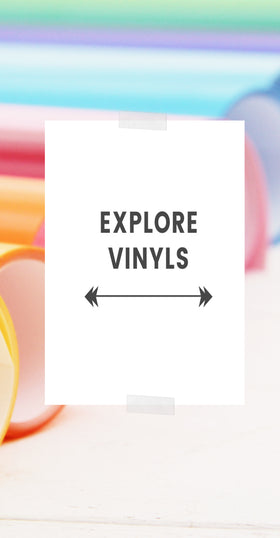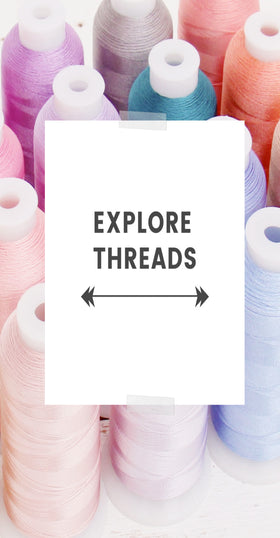Arrives in 2-6 Days

A Beginner's Guide to Understanding Thread
Embarking on a journey through the world of sewing can seem daunting, particularly when faced with the vast array of threads that exist. From different materials and construction methods to diverse sizes and weights, understanding threads can be perplexing even to the most knowledgeable sewing enthusiasts. This guide aims to provide you with the factual information needed to make informed choices about thread selection for your projects.

Raw Materials for Thread
All sewing threads begin as simple yarns, created by twisting together short fibers or continuous filaments. The result of this process, known as “singling twist”, is a thread with strength and flexibility, essential characteristics for a good sewing thread.
Threads can be made from an array of fibers, both natural and synthetic:
-
Natural Fibers
- Animal-based: silk, wool
- Vegetable-based: cotton, flax, jute
-
Regenerated Fibers
- Cellulose-based: rayon, acetate
-
Man-made Fibers
- Mineral-based: glass, metallic
- Synthetic-based: polyester, nylon, acrylic
It's worth noting that synthetic threads such as polyester have become increasingly popular over the years due to their durability and versatility.
How is Thread Made?
Ply
The ply of a thread refers to the number of component strands twisted together to produce it. A two-ply thread, for example, is made from two individual strands twisted together.
Twist
Twisting together short fibers or continuous filaments produce thread. Twist gives the thread strength and flexibility. Without twist the individual fiber strands would separate as they pass thru the needle or fabric.
Thread Finishing
After construction, threads undergo a finishing process to enhance their suitability for various sewing uses. Some common thread finishes include:
- Mercerized: Cotton thread treated in a caustic solution to increase its affinity for dyeing and add strength.
- Gassed: Thread passed through a flame at high speed to reduce the fuzz and produce a higher sheen.
- Bonded: Continuous filament nylon or polyester treated with a special resin that adds to the thread's ability to resist abrasion.
Thread Sizes
Thread size indicates the thickness of the thread. Heavier threads (lower numbers) are thicker, stronger, and create more visible stitches. Lighter threads (higher numbers) are thinner and less visible. For most general sewing, a 40 or 50 wt thread is typically used.
In general, it's best to match your sewing thread to your fabric. For instance, use cotton thread for cotton fabric, and so on. However, the all-purpose thread can be a great choice when your fabric is a blend or when you want a versatile thread.
Choosing the right sewing thread is essential for the success of your sewing projects. By considering the type of fabric you're using and the purpose of your project, you can select the most appropriate thread to ensure beautiful and durable results.
Thread Types
When discussing thread types, it is essential to consider several types beyond the ones we have already covered in this article. For an extensive guide to the world of thread, let's explore the categories of embroidery thread, bobbin thread, heavy-duty thread, quilting thread, and metallic thread.
Embroidery Thread
Embroidery Thread is used for machine or hand embroidery. It is typically made from polyester or rayon, which provides a beautiful sheen. Polyester embroidery thread has gained popularity for its durability and resistance to bleach. The thread's weight typically ranges between 30wt. and 40wt., where the 40wt. size being most common for machine embroidery. Our shop at ThreadArt.com offers a wide range of embroidery thread colors and types.
Bobbin Thread
Bobbin Thread is a lightweight thread for machine embroidery or machine basting. When embroidering, it is used in the bobbin on the machine's underside and makes up the embroidery's backside. White bobbin thread is commonly used, but you can also find it in black and in various colors. While white and black suit most embroidery needs, colored bobbin thread can be used when the back of the embroidery will be visible and needs to match the front. The weight of bobbin thread is usually 60wt.
Sewing Thread
Sewing Thread is the most common type of thread that you will encounter in any crafting project. It is used to stitch pieces of fabric together, either by hand or using a sewing machine. There are several types of sewing thread, each designed for specific fabrics and applications. The most popular is All-Purpose Polyester Thread. This thread is core spun featuring a continuous filament core covered with softer polyester fiber. This type of thread has the flexibility and stretch of polyester, with the softness and smoothness of cotton, making it suitable for a wide variety of sewing projects. Cotton Thread is made from 100% cotton and is a good choice for sewing light to medium weight fabrics, particularly natural fibers like cotton fabric itself. It has a good amount of give, which makes it flexible and able to move with the fabric. It's also a popular choice for quilting.
Heavy-Duty Thread
Heavy-Duty Thread is a strong and sturdy thread suitable for sewing heavy fabrics like denim, leather, and canvas. It's also ideal for making outdoor gear like tents, or items that will undergo heavy wear and tear, like luggage. Heavy-duty thread is often made from polyester like our serger thread, but can also be made from nylon or cotton. Bonded nylon thread heavy-duty thread is ideal for outdoor items as it is resistant to UV rays and moisture.
Quilting Thread
Quilting Thread is designed specifically for the rigors of quilting, often made from cotton or polyester. The choice between cotton and polyester depends on the fabric used in the quilt. If the quilt is made of cotton, many quilters prefer to use cotton thread. For synthetic quilts, polyester thread is often the choice. Quilting thread is typically 40wt or 50wt, but heavier, decorative threads such as pearl cotton thread are also used for topstitching.
Crochet Thread
Crochet thread is specifically designed for crocheting and other needlework like tatting or lace making. It is traditionally used to create doilies, tablecloths, and other fine home textiles. It can also be used to create intricate lace garments or pieces of jewelry. Crochet thread differs from traditional yarn in that it is thinner, comes in smaller sizes, and results in a much finer and more delicate finished project.
Metallic Thread
Finally, we have the Metallic Thread, which is a specialty thread used for decorative purposes. This thread is made from a core wrapped in a metallic foil and is available in a wide variety of colors. Metallic thread is most often used for decorative topstitching or machine embroidery, but it can also be used to add sparkle to knit and crochet projects.

Remember that no matter which type of thread you choose, the most important thing is to select a thread that suits your specific project. Each thread type has its unique properties and uses, so always consider the project's requirements and the characteristics of the fabric you're working with.


